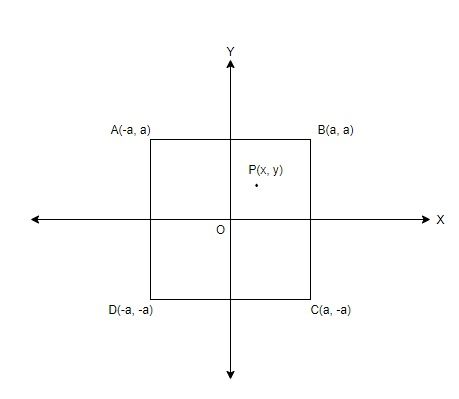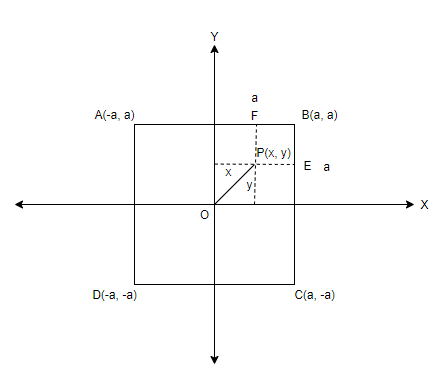
Answer
497.4k+ views
Hint: To solve this question, drawing a figure with all details is necessary. The distances can be found out using the distance formula as well as by subtracting or adding the coordinates.
Complete step-by-step answer:
The vertices of the square are given in the question as $\left( \pm a,\pm a \right)$. Let point $P$ have coordinates as $\left( x,~y \right)$.
A plot is made with the square and the point P in the \[x-y\] plane, taken in the first quadrant.

Next step is to mark the distance $a$ of the square in the plot. Then mark the distances $x$ and $y$ corresponding to the coordinates of point $P$. Consider points \[E\] and \[F\] to sides of the square \[BC\] and $AB$ respectively, as shown below,

The distance of the point $P$ having coordinates $\left( x,~y \right)$ to the centre \[O\], i.e. the origin can be written using the distance formula as,
$OP=\sqrt{{{x}^{2}}+{{y}^{2}}}$
The distance from point $P$ to the sides \[BC\] and $AB$ is given by $PE$ and \[PF\] respectively. The distances can be obtained by subtracting the coordinates that are given in terms of $x,~y$ and $a$ by referring to the plot. The distances are,
$PE=x$ coordinate of $E-x$ coordinate of $P=\left| \left( a-x \right) \right|$
$PF=y$ coordinate of $F-y$ coordinate of $P=\left| \left( a-y \right) \right|$
It is said in the question that the point $P$ is nearer to the centre than to the sides.
Therefore, we have the relation as,
$PE>OP~\And ~PF>OP$
So, we can formulate two equations by substituting the distances as,
$\left| \left( a-x \right) \right|>\sqrt{{{x}^{2}}+{{y}^{2}}}\ldots \ldots \ldots ~~\left( i \right)$
$\left| \left( a-y \right) \right|>\sqrt{{{x}^{2}}+{{y}^{2}}}\ldots \ldots \ldots ~~\left( ii \right)$
Now, we have to consider the distances to the other two sides also, so consider another set of points $G$ and \[H\], as shown below,

The distance from point $P$ to the sides $AD$ and \[DC\] is given by $PG$ and \[PH\] respectively. The distances can be obtained by subtracting the coordinates that are given in terms of $x,~y$ and $a$ by referring to the plot. The distances are,
$PG=x$ coordinate of $G-x$ coordinate of $P=\left| \left( -a-x \right) \right|=\left| \left( a+x \right) \right|$
$PH=y$ coordinate of $H-y$ coordinate of $P=\left| \left( -a-y \right) \right|=\left| \left( a+y \right) \right|$
As per the condition in the question that the point $P$ is nearer to the centre than to the sides, we have the relation as,
$PG>OP~\And ~PH>OP$
So, we can formulate two equations by substituting the distances as,
$\left| \left( a+x \right) \right|>\sqrt{{{x}^{2}}+{{y}^{2}}}\ldots \ldots \ldots ~~\left( iii \right)$
$\left| \left( a+y \right) \right|>\sqrt{{{x}^{2}}+{{y}^{2}}}\ldots \ldots \ldots ~~\left( iv \right)$
We have four equations $\left( i \right),~\left( ii \right),~\left( iii \right)$ and $\left( iv \right)$. The region in which $P$ will be bounded by parts of parabola can be found by simplifying the four equations.
Squaring and equating both sides of the equations $\left( i \right),~\left( ii \right),~\left( iii \right)$ and $\left( iv \right)$,
$\left( i \right)~\ldots \ldots \ldots ~~{{\left| \left( a-x \right) \right|}^{2}}={{\sqrt{{{x}^{2}}+{{y}^{2}}}}^{2}}$
${{a}^{2}}+{{x}^{2}}-2ax={{x}^{2}}+{{y}^{2}}$
${{y}^{2}}={{a}^{2}}-2ax\ldots \ldots \ldots ~~\left( v \right)$
$\left( ii \right)\ldots \ldots \ldots ~~{{\left| \left( a-y \right) \right|}^{2}}={{\sqrt{{{x}^{2}}+{{y}^{2}}}}^{2}}$
${{a}^{2}}+{{y}^{2}}-2ay={{x}^{2}}+{{y}^{2}}$
${{x}^{2}}={{a}^{2}}-2ay\ldots \ldots \ldots ~~\left( vi \right)$
$\left( iii \right)\ldots \ldots \ldots ~~{{\left| \left( a+x \right) \right|}^{2}}={{\sqrt{{{x}^{2}}+{{y}^{2}}}}^{2}}$
${{a}^{2}}+{{x}^{2}}+2ax={{x}^{2}}+{{y}^{2}}$
${{y}^{2}}={{a}^{2}}+2ax\ldots \ldots \ldots ~~\left( vii \right)$
$\left( iv \right)\ldots \ldots \ldots ~~{{\left| \left( a+y \right) \right|}^{2}}={{\sqrt{{{x}^{2}}+{{y}^{2}}}}^{2}}$
${{a}^{2}}+{{y}^{2}}+2ay={{x}^{2}}+{{y}^{2}}$
${{x}^{2}}={{a}^{2}}+2ay\ldots \ldots \ldots ~~\left( viii \right)$
Therefore, the equations $\left( v \right),~\left( vi \right),~\left( vii \right)$ and $\left( viii \right)$ represent the equations of the parts of parabolas that the point $P$ is bounded by. They are,
${{y}^{2}}={{a}^{2}}-2ax$
${{x}^{2}}={{a}^{2}}-2ay$
${{y}^{2}}={{a}^{2}}+2ax$
${{x}^{2}}={{a}^{2}}+2ay$
Therefore, by looking at the options, we get options a,b and c as the correct answers.
Option a, b and c
Note: In the question, the point $P$ lies in the \[x-y\] plane, so the point can be considered in any quadrant in the plot. The coordinates and hence the distances would change accordingly for the sides of the square considered. Ultimately, the final answer would be the same.
Complete step-by-step answer:
The vertices of the square are given in the question as $\left( \pm a,\pm a \right)$. Let point $P$ have coordinates as $\left( x,~y \right)$.
A plot is made with the square and the point P in the \[x-y\] plane, taken in the first quadrant.

Next step is to mark the distance $a$ of the square in the plot. Then mark the distances $x$ and $y$ corresponding to the coordinates of point $P$. Consider points \[E\] and \[F\] to sides of the square \[BC\] and $AB$ respectively, as shown below,

The distance of the point $P$ having coordinates $\left( x,~y \right)$ to the centre \[O\], i.e. the origin can be written using the distance formula as,
$OP=\sqrt{{{x}^{2}}+{{y}^{2}}}$
The distance from point $P$ to the sides \[BC\] and $AB$ is given by $PE$ and \[PF\] respectively. The distances can be obtained by subtracting the coordinates that are given in terms of $x,~y$ and $a$ by referring to the plot. The distances are,
$PE=x$ coordinate of $E-x$ coordinate of $P=\left| \left( a-x \right) \right|$
$PF=y$ coordinate of $F-y$ coordinate of $P=\left| \left( a-y \right) \right|$
It is said in the question that the point $P$ is nearer to the centre than to the sides.
Therefore, we have the relation as,
$PE>OP~\And ~PF>OP$
So, we can formulate two equations by substituting the distances as,
$\left| \left( a-x \right) \right|>\sqrt{{{x}^{2}}+{{y}^{2}}}\ldots \ldots \ldots ~~\left( i \right)$
$\left| \left( a-y \right) \right|>\sqrt{{{x}^{2}}+{{y}^{2}}}\ldots \ldots \ldots ~~\left( ii \right)$
Now, we have to consider the distances to the other two sides also, so consider another set of points $G$ and \[H\], as shown below,

The distance from point $P$ to the sides $AD$ and \[DC\] is given by $PG$ and \[PH\] respectively. The distances can be obtained by subtracting the coordinates that are given in terms of $x,~y$ and $a$ by referring to the plot. The distances are,
$PG=x$ coordinate of $G-x$ coordinate of $P=\left| \left( -a-x \right) \right|=\left| \left( a+x \right) \right|$
$PH=y$ coordinate of $H-y$ coordinate of $P=\left| \left( -a-y \right) \right|=\left| \left( a+y \right) \right|$
As per the condition in the question that the point $P$ is nearer to the centre than to the sides, we have the relation as,
$PG>OP~\And ~PH>OP$
So, we can formulate two equations by substituting the distances as,
$\left| \left( a+x \right) \right|>\sqrt{{{x}^{2}}+{{y}^{2}}}\ldots \ldots \ldots ~~\left( iii \right)$
$\left| \left( a+y \right) \right|>\sqrt{{{x}^{2}}+{{y}^{2}}}\ldots \ldots \ldots ~~\left( iv \right)$
We have four equations $\left( i \right),~\left( ii \right),~\left( iii \right)$ and $\left( iv \right)$. The region in which $P$ will be bounded by parts of parabola can be found by simplifying the four equations.
Squaring and equating both sides of the equations $\left( i \right),~\left( ii \right),~\left( iii \right)$ and $\left( iv \right)$,
$\left( i \right)~\ldots \ldots \ldots ~~{{\left| \left( a-x \right) \right|}^{2}}={{\sqrt{{{x}^{2}}+{{y}^{2}}}}^{2}}$
${{a}^{2}}+{{x}^{2}}-2ax={{x}^{2}}+{{y}^{2}}$
${{y}^{2}}={{a}^{2}}-2ax\ldots \ldots \ldots ~~\left( v \right)$
$\left( ii \right)\ldots \ldots \ldots ~~{{\left| \left( a-y \right) \right|}^{2}}={{\sqrt{{{x}^{2}}+{{y}^{2}}}}^{2}}$
${{a}^{2}}+{{y}^{2}}-2ay={{x}^{2}}+{{y}^{2}}$
${{x}^{2}}={{a}^{2}}-2ay\ldots \ldots \ldots ~~\left( vi \right)$
$\left( iii \right)\ldots \ldots \ldots ~~{{\left| \left( a+x \right) \right|}^{2}}={{\sqrt{{{x}^{2}}+{{y}^{2}}}}^{2}}$
${{a}^{2}}+{{x}^{2}}+2ax={{x}^{2}}+{{y}^{2}}$
${{y}^{2}}={{a}^{2}}+2ax\ldots \ldots \ldots ~~\left( vii \right)$
$\left( iv \right)\ldots \ldots \ldots ~~{{\left| \left( a+y \right) \right|}^{2}}={{\sqrt{{{x}^{2}}+{{y}^{2}}}}^{2}}$
${{a}^{2}}+{{y}^{2}}+2ay={{x}^{2}}+{{y}^{2}}$
${{x}^{2}}={{a}^{2}}+2ay\ldots \ldots \ldots ~~\left( viii \right)$
Therefore, the equations $\left( v \right),~\left( vi \right),~\left( vii \right)$ and $\left( viii \right)$ represent the equations of the parts of parabolas that the point $P$ is bounded by. They are,
${{y}^{2}}={{a}^{2}}-2ax$
${{x}^{2}}={{a}^{2}}-2ay$
${{y}^{2}}={{a}^{2}}+2ax$
${{x}^{2}}={{a}^{2}}+2ay$
Therefore, by looking at the options, we get options a,b and c as the correct answers.
Option a, b and c
Note: In the question, the point $P$ lies in the \[x-y\] plane, so the point can be considered in any quadrant in the plot. The coordinates and hence the distances would change accordingly for the sides of the square considered. Ultimately, the final answer would be the same.
Recently Updated Pages
Fill in the blanks with suitable prepositions Break class 10 english CBSE

Fill in the blanks with suitable articles Tribune is class 10 english CBSE

Rearrange the following words and phrases to form a class 10 english CBSE

Select the opposite of the given word Permit aGive class 10 english CBSE

Fill in the blank with the most appropriate option class 10 english CBSE

Some places have oneline notices Which option is a class 10 english CBSE

Trending doubts
Fill the blanks with the suitable prepositions 1 The class 9 english CBSE

How do you graph the function fx 4x class 9 maths CBSE

When was Karauli Praja Mandal established 11934 21936 class 10 social science CBSE

Which are the Top 10 Largest Countries of the World?

What is the definite integral of zero a constant b class 12 maths CBSE

Why is steel more elastic than rubber class 11 physics CBSE

Distinguish between the following Ferrous and nonferrous class 9 social science CBSE

The Equation xxx + 2 is Satisfied when x is Equal to Class 10 Maths

Differentiate between homogeneous and heterogeneous class 12 chemistry CBSE




